Chickweed is a common lawn weed that can cause significant damage to your grass if left unchecked. People are often fooled by its cheerful-looking flowers, but allowing chickweed to grow freely is the last thing you want to do. This weed has become increasingly prevalent in lawns across the Pacific Northwest, so it is important for homeowners and lawn care enthusiasts alike to be aware of the risks associated with having chickweed on their property. In this article, we’ll go over what chickweed is, how it grows, and how you can control it and maintain the healthiest lawn possible this season!
Identifying Chickweed
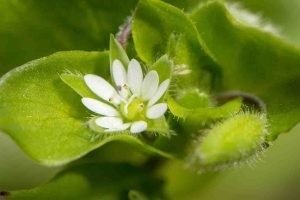
Chickweed (also known as "common chickweed") is an annual, broadleaf weed that is identifiable by the flowers it develops as the plant matures. Because of these attractive little flowers, some people don't mind having chickweed in their lawns. However, it is important to remember that chickweed is still a harmful weed with shallow roots that will steal nutrients away from your lawn, resulting in thinner and discolored grass.
Stellaria media is the species name of common chickweed. The genus name, Stellaria, is derived from the Latin word for "star," and it refers to the shape of chickweed's flowers. People very frequently mistake chickweed flowers for having 10 petals. This is because the 5 white petals are fused together at their base, making it appear as though there are 10. However, if you look closely, you will see that the petals are just deeply lobed. It is also very important to point out that not all chickweed plants will develop flowers, but other common characteristics will still be present.
The stems of common chickweed can also help you positively identify this plant. Chickweed stems are usually described as having a purple or a deep red hue, which stands out among the whites and greens on the rest of the plant. The stems also have a single line of very fine hairs going down either side of the stem. This line of hairs is useful in identifying common chickweed because similar types of plants often have stems with no hairs or they are completely covered in hairs. The stems are low-growing, and they frequently become tangled and matted in a lawn or garden.
Key Characteristics:
-Star-shaped flower and sepal
-5 deeply lobed, white petals
-Matted and tangled growth
-Single line of fine hairs on stem
-Purple or red hue on stem
-Low growth
What Does Chickweed Do To Lawns?
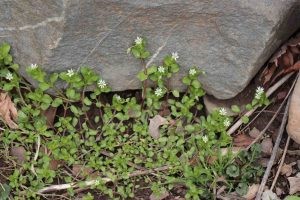
While some people might consider chickweed to be nothing more than a nuisance weed, it can actually cause quite a bit of damage to your lawn. Chickweed is a very competitive plant, and it will quickly crowd out other plants in your lawn if given the chance. Because of the fibrous root system of chickweed, it is extremely difficult to control it once it starts spreading its roots in your lawn. Before long, your grass will start to weaken as the shallow roots of chickweed get first dibs on all the moisture and nutrients that seep through the soil surface.
Chickweed grows very low to the ground, which is known to cause a number of additional issues for turfgrass. Once a chickweed plant has established itself, it will start expanding by way of outward growth of both stems and underground roots. This method of expansion is known to cause severe matting, which leads to the formation of ugly patches of tangled weeds that are difficult to remove and strangle the desired turfgrass in your lawn. Most importantly, chickweed will litter your yard with seeds that can produce new plants years later, making their growth habits very unpredictable.
When & Where Does Chickweed Grow?

Chickweed is a winter annual that prefers cooler temperatures for optimal growth. Common chickweed in our area typically emerges in fall, goes dormant through winter, and sets seed in late spring or early summer before the plant dies. This is the case for common chickweed in cooler climates, but other types of chickweed can last for several years where winters are not so cold.
Common chickweed can be found all over the world, and it is widespread across most habitable areas of North America. It prefers cool and moist soil, and its shallow root system thrives in poorly draining soils that hold a lot of moisture near the surface. Chickweed is commonly seen in lawns, but it can also grow in gardens, flower beds, and other areas of your landscape. Below is a list of some of the most common conditions that lead to a chickweed infestation:
-Direct sunlight
-Moist soil
-Too much nitrogen
-Compacted soil
-Soil at 50 - 65 degrees Fahrenheit
-Short grass in lawns
How Chickweed Spreads
As is the case for most annual lawn weeds, chickweed does not live long enough to develop a deep and complex root system. Because of this, seed dispersal is the primary way by which this weed spreads. A single chickweed plant produces anywhere between 800 and 30,000 seeds. These seeds are capable of remaining viable in the soil for up to 10 years, which is why it is so important to take care of a chickweed invasion as early as possible.
How To Control Chickweed
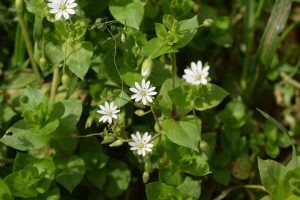
Once a chickweed invasion has begun, it can be extremely difficult to remove the emerged plants. The shallow roots and low-growing stems can regenerate growth if even a small fragment is left in the soil when trying to pull them out. You should plan to combat chickweed in early spring, well before the plant begins to set seeds. Keep the following tips in mind when dealing with chickweed in your lawn this season!
-Avoid Hand-Pulling: It can be difficult to fully remove a matted mess of chickweed by hand.
-Dig With Tools: Gardening tools like a shovel or spade can help ensure that no fragments get left behind.
-Aerate Your Lawn: Spring and fall aeration will help your lawn drain properly, which deters moisture-loving chickweed.
-Leave Grass Tall: Keeping your lawn at around 4 inches tall can help block sunlight from reaching low-growing chickweed.
-Monitor Nitrogen: Chickweed thrives in soil with excess nitrogen, so be sure to use a season-appropriate fertilizer.
-Call Simple Lawns: If you are in the Portland area, call Simple Lawns today! We can help with pre-emergent and post-emergent herbicide applications and anything else your lawn may need!
Subscribe to Simple Lawns's Blog




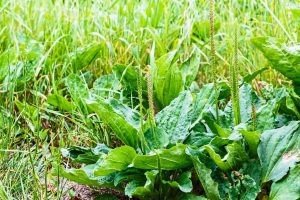
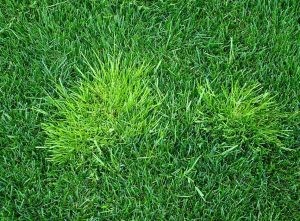
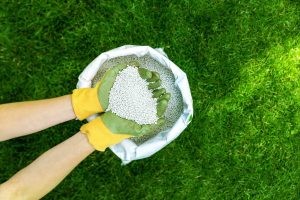
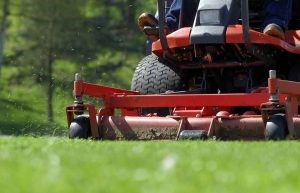

Comments